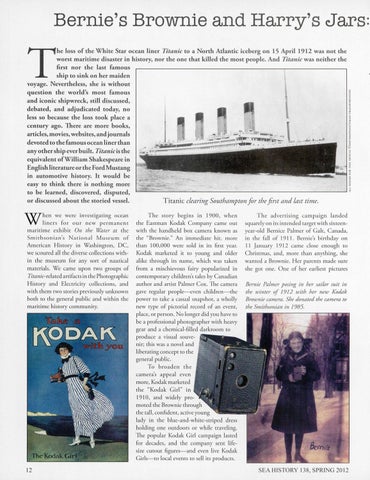Bernie's Brownie and Harry's Jars:
T
he loss of the White Star ocean liner Titanic to a North Atlantic iceberg on 15 April 1912 was not the worst maritime disaster in history, nor the one that killed the most people. And Titanic was neither the first nor the last famous ship to sink on her maiden voyage. Nevertheless, she is without question the world's most famous and iconic shipwreck, still discussed, debated, and adj udicated today, no less so because the loss took place a century ago. There are more books, articles, movies, websites, and journals devoted to the famous ocean liner than any other ship ever built. Titanic is the equivalent ofWilliam Shakespeare in English literature or the Ford Mustang in automotive history. It would be easy to think there is nothing more to be learned, discovered, disputed, or discussed about the storied vessel. Titanic clearing Southampton fo r the first and last time.
W
hen we were inves tigating ocean lin e rs for our n ew pe rm an ent maritim e exhibit On the 'Xater at the Smithsoni a n's Na tion al Muse um of American History in Washington, D C, we scoured all the diverse collections within the museum for any sort of nautical materials. We came upon two groups of Titanic-related artifacts in the Photographic History and Electricity collections, and with them two stories previously unknown both to the general public and within the maritime history communi ty.
12
T he story begins in 1900, w hen the Eastman Kodak Company cam e ou t with the handheld box camera kn own as rhe "Brownie." An immediate hit, more than 100,000 were sold in its first year. Kodak marketed it to young and older alike through its name, which was taken from a mischievous fairy popularized in contemporary children's tales by Canadian author and artist Palmer Cox. 1he cam era gave regular people-even children- the power to take a casual snapsho t, a wholly new type of pictorial record of an event, place, or person. N o longer did yo u have to be a professional photographer with heavy gear and a chemical-filled darkroom to produce a visual so uvenir; this was a novel and liberating concept to the general public. To bro ad e n the camera's appeal even more, Kodak marketed the "Kodak Girl " in 1910, and widely promoted the Brownie through the tall, confident, active yo ung lady in the blue-and-white-striped dress holding one outd oors or while traveling. The popular Kodak G irl campaign las ted for decades, and the company sent lifesize cuto ut figures-and even live Kodak Girls-to local events to sell its products.
T he advertising camp aign landed squ arely o n its intended targe t with sixteenyea r-old Bernice Palmer of Galt, Canada, in the fall of 19 11. Bernie's birthday on 11 Janu ary 1912 came close eno ugh to Ch ristmas, and, mo re than anything, she wanted a Browni e. H er parents m ade sure she got one. O ne of her earliest pictures
Bernie Palmer posing in her sailor suit in the winter of 19 12 with her new Kodak Brownie camera. She donated the camera to the Smithsonian in 1985.
SEA HISTORY 138, SPRING 2012
